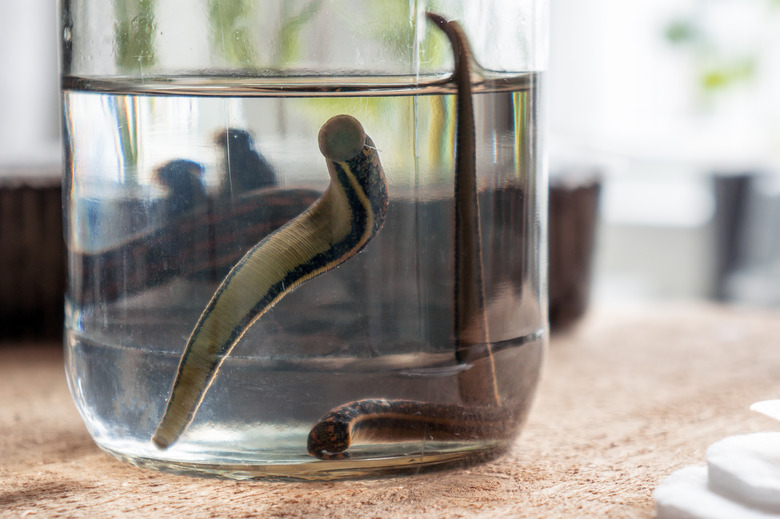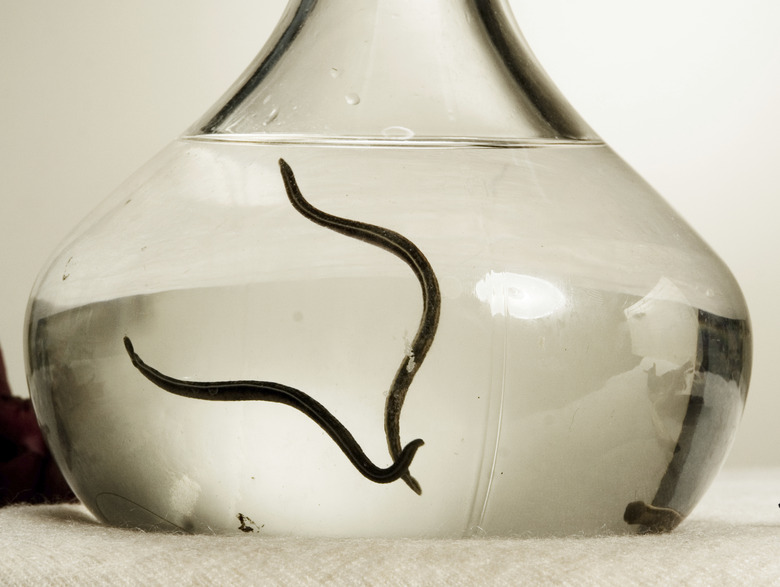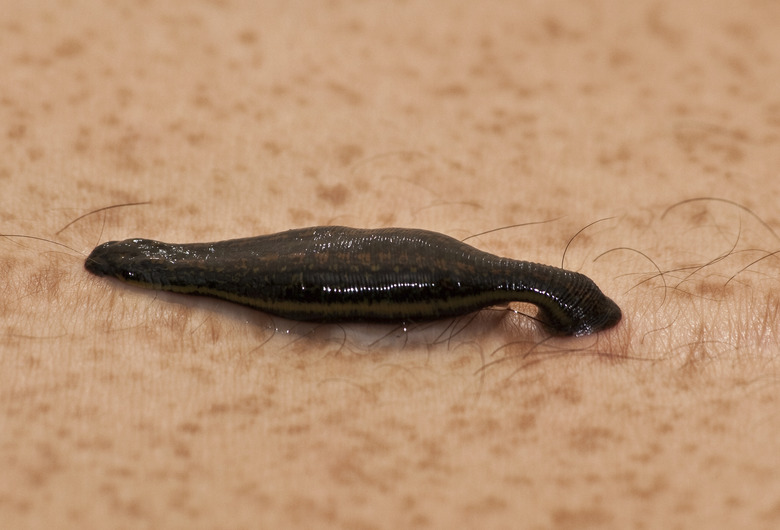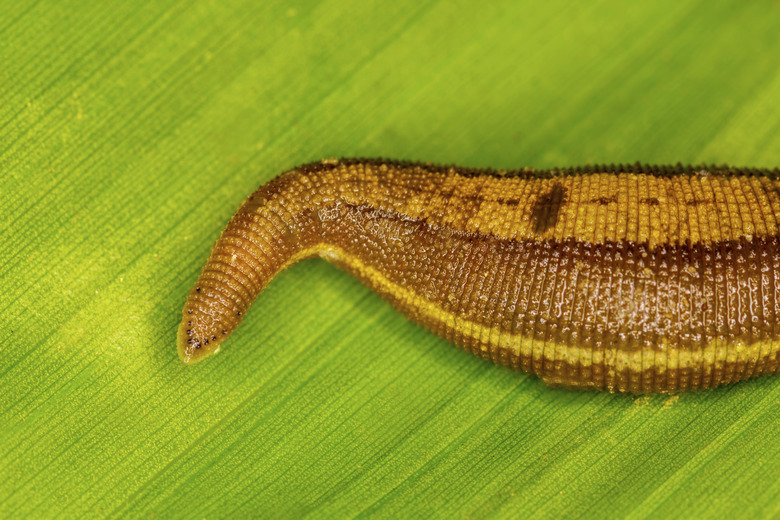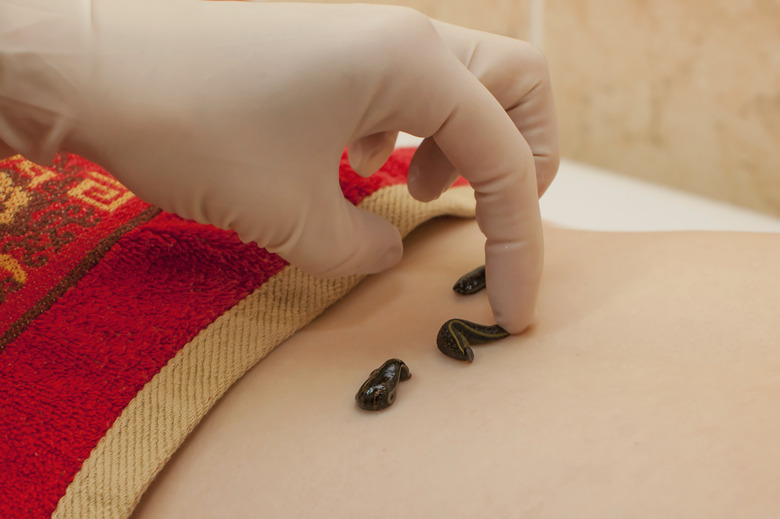Life Cycle Of Leeches
Leeches are segmented worms that live in a wide rage of environments, including fresh water, salt water and on land. The are hermaphroditic and produce young from eggs stored in cocoons. Some leeches are carnivorous and swallow their prey whole, but most are parasitic, latching onto and moving across their hosts with two sucking discs positioned on either end of their bodies. Bloodsucking leeches release anesthetic chemicals, anticoagulants and antibiotics into their hosts so the bite isn't felt, the blood flows freely and there is little chance of infection.
Reproduction
Reproduction
All leeches are hermaphrodites, meaning each one has both male and female reproductive organs. However, they do reproduce sexually–usually by intertwining their bodies together. One leech's male organ release a spermatophore, or a capsule that encloses sperm, which is then attached to the other leech. Once attached, the sperm exits the spermatophore and makes its way through the skin of the other leech. Once inside, it travels to the ovaries and fertilizes the eggs.
Eggs
Eggs
Leeches make cocoons in which to deposit their eggs. A leech secretes its cocoon from glands–the cocoon initially encases the leech itself. When the cocoon slips off the leech’s body, the fertilized eggs attach to the cocoon and go with it. Leeches attach their cocoons to substrates such as rocks or plants.
Oftentimes, there's a delay between egg fertilization and egg deposition; in the case of one leech type, up to 9 months might pass between copulation and cocoon secretion. In some species, egg development in the cocoon is as short as a week. In others, egg development takes longer and requires more parental care. Thin-walled cocoons, for example, require that the caretaking leech cover it with its body until the eggs mature. Newborn leeches attach to their caretaker's body, which they leave as soon as a suitable host is in the vicinity and they can feed. After their first meal, they're completely independent.
Juveniles
Juveniles
Leeches are epimorphic, meaning they pass through the stages of growth without changing fundamentally. The juvenile that emerges from the cocoon has the same number of segments for its entire life unlike earthworms, which add segments as they grow. Also unlike earthworms, leeches can't regenerate a part of their body that has been severed. During the juvenile stage, leeches demonstrate two types of growth depending on their type. Those with fast digestion feed regularly and grow continuously, while those with slow digestion grow in spurts and can go for long stretches of time without feeding.
Adults
Adults
Leeches achieve adulthood either when they reach their critical body weight or once they reach sexual maturity, depending on the type. The average adult leech is typically between 15 and 30 mm long, however, leeches as long as 200 mm have been found in tropical regions. Leeches die after reproducing once or, in some cases, twice. Nevertheless, leeches may live for months or a year prior to reproduction and can also survive the same length of time in between feedings.
Food Sources
Food Sources
Leech species tend to be specific, attacking either fish, amphibians, reptiles, birds or mammals, with little overlap. Their food sources vary as widely as their habitats and distinct species. A leech that feeds primarily on water fowl, for example, can first attach to any part of the bird and make its way to the bird's head, where it attaches to feed either at the bird's eye or the inside of its nostril.
Leeches that feed on mammals don't differentiate between cows, horses, humans or dogs; any mammal will do. Likewise, leeches that feed on fish don't feed exclusively on one specific type of fish, but will feed off any fish.
References
Cite This Article
MLA
Campbell, Meg. "Life Cycle Of Leeches" sciencing.com, https://www.sciencing.com/life-cycle-leeches-6739035/. 23 April 2018.
APA
Campbell, Meg. (2018, April 23). Life Cycle Of Leeches. sciencing.com. Retrieved from https://www.sciencing.com/life-cycle-leeches-6739035/
Chicago
Campbell, Meg. Life Cycle Of Leeches last modified March 24, 2022. https://www.sciencing.com/life-cycle-leeches-6739035/
